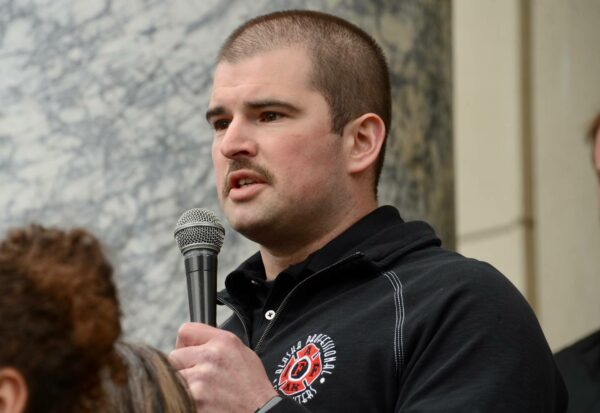
With the state of Alaska struggling to hire and retain employees amid the “Great Resignation,” state legislators are more earnestly considering new pension programs for state employees.
Lawmakers abolished pensions for new employees in 2006 amid a multibillion-dollar shortfall in the pension fund, replacing them with a 401(k)-style retirement system. Proposals to reverse that decision have been introduced with regularity since then, but none have come close to becoming law. This year, unprecedented hiring problems and a shrinking pension liability are changing the equation.
“The single biggest change is the desperate situation we have in recruiting and keeping everyone from troopers to teachers to firefighters to wastewater plant operators,” said Sen. Jesse Kiehl, D-Juneau.
On Thursday, dozens of firefighters gathered on the steps of the Capitol to rally support for House Bill 55, a measure that would create a pension for police and firefighters. It passed the House last year and is now in the Senate.
If it becomes law, HB 55 would create a new pension fund for police and firefighters, who would be required to contribute at least 8% of their pay and could retire at age 55 if they work for 20 years.
An analysis published this month found the program would cost the state between $4 million and $7 million per year. Proponents say that’s less than the cost of hiring and training replacements for public safety workers who leave the state because there’s no pension.
“I think a lot of legislators are starting to realize that when they hear from these chiefs and heads of these departments that this is a real problem,” said Paul Miranda, president of the Alaska Professional Fire Fighters Association.

In large part, the rally’s goal was to convince Sen. Mia Costello, R-Anchorage, to advance the bill. Costello is the chair of the Senate Labor and Commerce Committee, which reviews pension legislation. Without her support, the bill won’t move.
She’s scheduled the bill for a hearing on Monday but has no immediate plans to move it forward.
“We have to make sure we’re doing the absolute right thing, and I’m not in any hurry. And I want to do a thorough review,” Costello said.
That’s a problem for proponents: Unless House Bill 55 advances, it will die with the end of the legislative session and have to start over from scratch at the start of 2023.
“There has never been a riskless system. There never will be, and right now, we’re the only state without a defined benefit, and that’s biting us hard,” Kiehl said.
Right now, Alaska has what’s known as a “defined contribution” retirement system. Employees pay a certain amount of money, the state pitches in a certain amount, and the retirement benefit depends on how well that money is invested.
Pensions are known as “defined benefit” retirement — the state assumes the responsibility for paying a certain amount of benefits, even if there’s not enough money saved to pay for them.
In the early 2000s, a stock market slump, changes in benefits and new actuarial estimates created a huge shortfall in the state’s pension system. By 2013, the gap exceeded $12 billion, and the state faced the prospect of paying up to $1 billion per year out of the state budget in order to fill it.
Improved investment returns, a $3 billion transfer from savings, and continued annual payments in the state budget shrank the shortfall by two-thirds, to $4 billion, in 2021.
That progress has encouraged the state to reduce the amount it spends on shrinking the gap, and it’s provided additional arguments for those who want to revive pensions.
But Costello and other legislators, including Sen. Bert Stedman, R-Sitka, have deep memories of the shortfall.
“In general, I want to make sure there’s no risk to the state,” she said. “You know, we have an unfunded liability right now, and I just want to make sure that, you know, for the next 50, 100 years, we’re doing right by our responsibility to keep the state not exposed to undue risk.”
That view has been supported by libertarian antigovernment groups like the Reason Foundation, Alaska Policy Forum and Americans for Prosperity. The latter group also took out a Facebook ad thanking Costello for her position.
In Thursday’s rally, legislator-turned-consultant Chuck Kopp took aim at the three groups.
“When tragedy comes and violence comes, it’s not the Alaska Policy Forum, Americans for Prosperity, or Reason Foundation that’s coming to stop the shooter, quench the flames and rescue the wounded,” he said.
Police and firefighters aren’t the only ones seeking pensions. NEA-Alaska, the state’s largest teachers’ union, has been supporting House Bill 220, from Rep. Grier Hopkins, D-Fairbanks. That bill would reopen the state’s now-closed pension programs. That bill is in front of the House Finance Committee, and Hopkins said he intends to make changes to the proposal; an initial analysis suggested it could cost as much as $70 million per year.
Even that cost could be worthwhile, proponents argue. Teacher turnover — the issue of teachers leaving and having to be replaced year over year — is linked to poor performance by students.
“What we have been seeing is what some have coined ‘education tourists,’ where educators come up for their Alaskan adventure, and work for five years and get vested in the defined contribution system. And then they’ll go back home to Michigan, or Minnesota or Washington, where they can still work a full career and receive a defined benefit retirement there,” said Tom Klaameyer, president of NEA-Alaska.
In 2017, a study by the University of Alaska Anchorage Center for Alaska Education Policy Research concluded that every teacher who left the state cost their district more than $20,000, the cost to recruit, hire and train a replacement.
In May 2020, Gov. Mike Dunleavy’s administration formed a group to study the causes of teacher turnover and recommend solutions.
A survey commissioned by the workgroup found that retirement was the No. 3 overall concern, behind salary and cost-of-living adjustments for rural teachers. In 2021, the group recommended six fixes. One of those six was a restructured retirement system for teachers.
The big question for legislators: What form will that restructured system take?
“I’m very hesitant to expose the state to a multiple-billion-dollar unfunded liability. That’s just not a prudent thing to do,” said Stedman, the co-chair of the Senate Finance Committee.
“I recognize that the employees would like a defined benefit plan. But citizens around the state don’t want to create an unfunded liability,” he said.
Rep. Andy Josephson, D-Anchorage, is the author of House Bill 55 and said if it passes the Legislature this year and is successful when implemented, it could serve as a model for other state agencies and employees.
Stedman said he has similar thoughts: If a system works for police and firefighters, why not offer it to all public employees?
“I don’t see why it wouldn’t go out to the whole system,” he said.




